
Looking for Mangoes - Where to get them, Facts, Tips, How to Use them in 2025? Scroll down this page and follow the links. And if you bring home some fruit or vegetables and want to can, freeze, make jam, salsa or pickles, see this page for simple, reliable, illustrated canning, freezing or preserving directions. There are plenty of other related resources, click on the resources dropdown above. If you are having a hard time finding canning lids, I've used these, and they're a great price & ship in 2 days.
If you have questions or feedback, please let me know! There are affiliate links on this page. Read our disclosure policy to learn more.
Mangoes - Where to get them, Facts, Tips, How to Use them
How to Make Homemade Canned Mangoes, Mango Chutney and Mango Salsa
You think making and canning your own mangoes, pears, plums, cherries or
nectarines is difficult or expensive? Not at all!
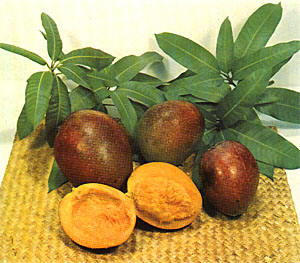 Here's
how to do it, complete instructions in easy steps and completely illustrated. In
the winter when you open a jar, the mangoes will taste MUCH better than anything
you've ever had from a store, and by selecting the right fruit, it will use less
sugar than store-bought canned mangoes. Mangoes, like many sweet stone or
pitted fruit, can be packed in very light, light or medium sugar syrup. They can
also be packed in water, apple juice or white grape juice.
Here's
how to do it, complete instructions in easy steps and completely illustrated. In
the winter when you open a jar, the mangoes will taste MUCH better than anything
you've ever had from a store, and by selecting the right fruit, it will use less
sugar than store-bought canned mangoes. Mangoes, like many sweet stone or
pitted fruit, can be packed in very light, light or medium sugar syrup. They can
also be packed in water, apple juice or white grape juice.
Prepared this way, the jars have a shelf life of about 12 to 18 months, and aside from storing in a cool, dark place, require no special attention. If you'd rather freeze your fruit, see my page on How to freeze mangos. You can freeze mangoes just like peaches. Even easier than canning and they will taste just like fresh.. but it does take up space in the freezer.
You may also be interested in How to make GREAT mango chutney! and How to make mango salsa. and Mango-raspberry jam
For more information about mangoes, see this page!
Directions for Making Canned Mangoes
Ingredients
- Fruit (see step 1)
- Sugar
- Lemon juice (1/4 cup) or Fruit-Fresh (2 tablespoons)
Equipment
- Jar grabber (to pick up the hot jars)
- Lid lifter (I like the lid rack that holds 12 lids or you can pull them out one at a time with the lid-lifter that has a magnet from the almost-boiling water where you sanitize them. ($4 at mall kitchen stores and local "big box" stores, but it's usually cheaper online from our affiliates)
- Jar funnel ($4 at mall kitchen stores and local "big box" stores, but it's usually cheaper online from our affiliates)
- At least 1 large pot
- Large spoons and ladles,
- Canning jars (often called Ball jars, Mason jars or Kerr jars) (Publix, Kroger, other grocery stores and some "big box" stores carry them - now about $12 per dozen quart jars (up 50% in 2 years!) including the lids and rings)
- 1 water bath canner (a huge pot with a lifting rack to sanitize the jars of mangoes after filling (about $30 to $35 at mall kitchen stores and local "big box" stores, but it's usually cheaper online from our affiliates) You CAN use a large pot instead, but the canners are deeper, and have a rack top make lifting the jars out easier. If you plan on canning every year, they're worth the investment.
Recipe and Directions
Step 1 - Selecting the mangoes
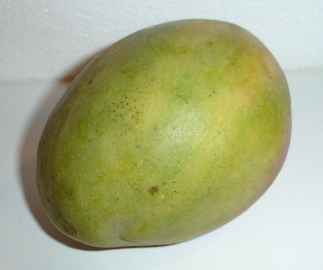 Choose
ripe, mature fruit of ideal quality for eating fresh or cooking. They
should not be mushy, but they also should not be rock hard: just as ripe
as you would eat them fresh. You can also use solid green mangoes.
Select firm, non-fibrous fruit.
Caution: Handling green mangoes may irritate the skin of some
people in the same way as poison ivy. (They belong to the same plant
family.) (see
this page for more information) To avoid this reaction, wear plastic
gloves while working with raw green mango. Do not touch your face, lips
or eyes after touching or cutting green mangoes until all traces are
washed away .
Choose
ripe, mature fruit of ideal quality for eating fresh or cooking. They
should not be mushy, but they also should not be rock hard: just as ripe
as you would eat them fresh. You can also use solid green mangoes.
Select firm, non-fibrous fruit.
Caution: Handling green mangoes may irritate the skin of some
people in the same way as poison ivy. (They belong to the same plant
family.) (see
this page for more information) To avoid this reaction, wear plastic
gloves while working with raw green mango. Do not touch your face, lips
or eyes after touching or cutting green mangoes until all traces are
washed away .
Step 2 - How many mangoes and where to get them
You can pick your own, or buy them at the grocery store in the summer months. But for large quantities, you will find that Costco, Sam's Club and BJ's seem to have the largest mangoes and best prices.
It takes about 5 good sized mangoes to fill one quart jar.
* - not the cutesy, fake farmer's markets that are just warehouse grocery stores that call themselves farmer's markets.
Step 3 - Prepare the sugar (or other sweetener) solution
Mangoes must be packed in a solution of water and sugar or fruit juice. It's up to you which to use. Sugar is added to improve flavor, help stabilize color, and retain the shape of the fruit. It is not added as a preservative. Sugar solution is much less expensive (unless you have a supply of cheap grape juice), so I usually use a light solution to keep sugar (and the added calories) to a minimum.
| Syrup | Sugar | Water | Yield |
| Light | 2 cups | 6 cups | 7 cups |
|---|---|---|---|
| Medium | 3 cups | 6 cups | 6 1/2 cups |
| Heavy | 4 cups | 6 cups | 7 cups |
To prepare syrup, while heating water, add sugar slowly, stirring constantly to dissolve. Bring to a gentle boil. Fill jars while syrup is still boiling hot. After preparing the liquid syrup, keep it hot (but not boiling).
Step 4 - Wash the jars and lids
This is a good time to get the jars ready! The dishwasher is fine for the jars; especially if it has a "sanitize" cycle. Otherwise put the jars in boiling water for 10 minutes. I just put the lids in a small pot of almost boiling water for 5 minutes, and use the magnetic "lid lifter wand" (available from WalMart) to pull them out.
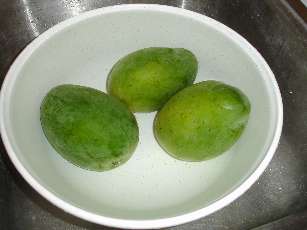 Step
5 -Wash the mangoes!
Step
5 -Wash the mangoes!
I'm sure you can figure out how to wash the mangoes in plain cold or lukewarm water.
Step 6 - Peeling the Mangoes
Nope, we're not going to peel them strictly by hand; that's way too much work. Instead, here's a great trick that works with many fruits and vegetables with skins (like tomatoes): just dip the fruit in boiling water for 60 seconds. Remove from the water using a slotted spoon and put into a large bowl or pot of cold water and ice. The skins will easily peel off more easily now! Mangoes are also MUCH easier to peel when slightly ripe.
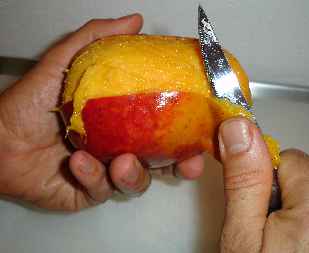
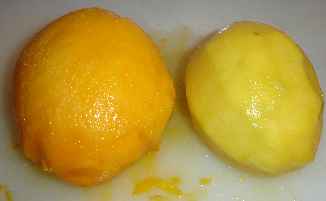
Step 7 - Cut up the mangoes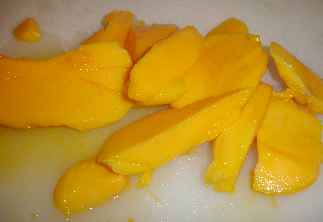
Cut out any brown spots and mushy areas. Slice the mangoes in 1/4 thick slices!
See here for related tools, equipment, supplies on Amazon This mango splitter works great!
Step 8 - Prevent the fruit from darkening!
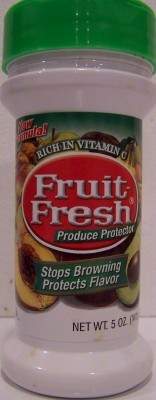 Now,
to keep the fruit from turning brown, when you get a bowlful, sprinkle
1/4 cup lemon juice or Fruit-Fresh (which is just a mix of citric acid
and vitamin C, perfectly natural). Then stir the mangoes to make
sure all the surfaces have been coated.
Now,
to keep the fruit from turning brown, when you get a bowlful, sprinkle
1/4 cup lemon juice or Fruit-Fresh (which is just a mix of citric acid
and vitamin C, perfectly natural). Then stir the mangoes to make
sure all the surfaces have been coated.
Step 9 - Fill the jars
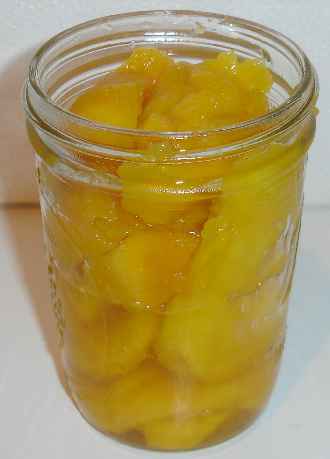 Pack
the mangoes into sanitized jars (leaving 1/2 to 1 inch space at the top)
Pack
the mangoes into sanitized jars (leaving 1/2 to 1 inch space at the top)
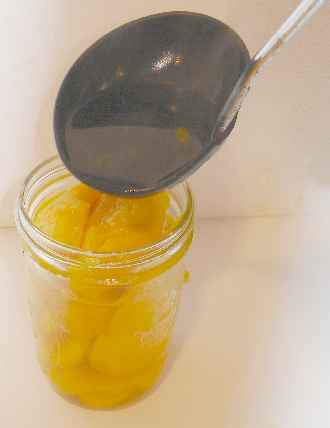 After
packing the mangoes in the jar, pour the sugar solution up to 1/2 inch (1
cm) from the top. the fruit should be covered completely. (Since
we don't cook or heat the mangoes first, this is called "cold packing").
After
packing the mangoes in the jar, pour the sugar solution up to 1/2 inch (1
cm) from the top. the fruit should be covered completely. (Since
we don't cook or heat the mangoes first, this is called "cold packing").
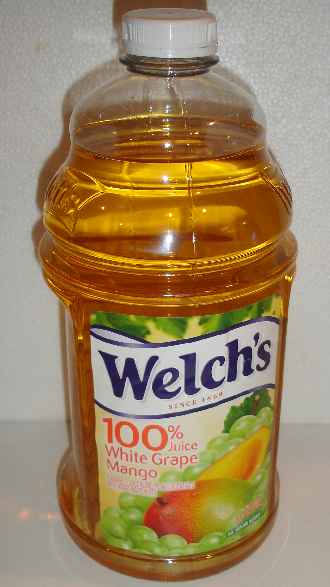 Canned
fruits often will float if the sugar syrup is too heavy, if jars are packed
too loosely or if air remains in the tissues of the fruit after processing.
To avoid this use a light or medium sugar syrup, make sure fruit is firm and
ripe and pack fruit tightly in jars without crushing.
Canned
fruits often will float if the sugar syrup is too heavy, if jars are packed
too loosely or if air remains in the tissues of the fruit after processing.
To avoid this use a light or medium sugar syrup, make sure fruit is firm and
ripe and pack fruit tightly in jars without crushing.
If fruit is not covered by liquid it may darken during storage (but does
not necessarily mean it is spoiled, as all fruits will darken somewhat). To
avoid this be sure fruit is covered by removing air bubbles from jars liquid
while still leaving the recommended head space. Also be sure to remove
trapped air bubbles as described earlier.
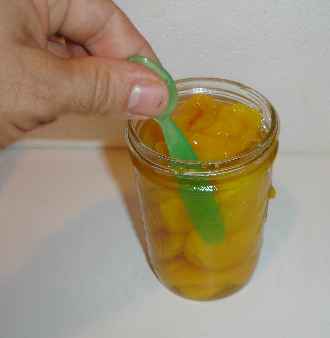 Run
a rubber spatula or table knife gently between mangoes and jar to release
trapped air bubbles. To do this more effectively, tilt the jar slightly
while running the tool between the fruit and the edge of the jar and also
pressing inward against the fruit a few times.
Run
a rubber spatula or table knife gently between mangoes and jar to release
trapped air bubbles. To do this more effectively, tilt the jar slightly
while running the tool between the fruit and the edge of the jar and also
pressing inward against the fruit a few times.
Wipe rim and screw threads with a clean damp cloth. Add lid, screw band and tighten firmly and evenly. Do not over tighten.
Step 10 - Process the jars in the water bath
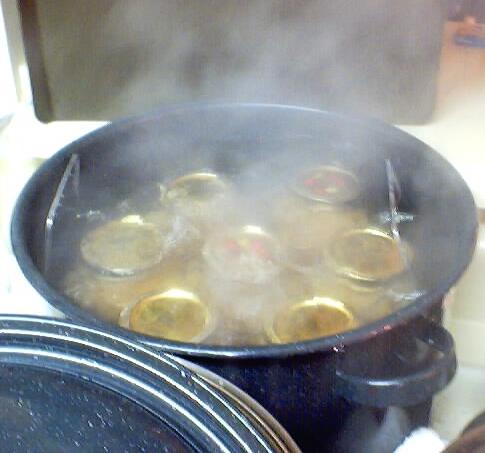 Put
the sealed jars in the canner and keep them cover with at least 1 inch
of water and boiling. Boil them for at least 20 minutes (and no more
than 30 min).
Put
the sealed jars in the canner and keep them cover with at least 1 inch
of water and boiling. Boil them for at least 20 minutes (and no more
than 30 min).
| Recommended process time for Mangoes in a boiling-water canner. | |||||
| Process Time at Altitudes of | |||||
| Style of Pack | Jar Size | 0 - 1,000 ft | 1,001 - 3,000 ft | 3,000 - 6,000 ft | Above 6,000 ft |
| Hot | Pints Quarts |
15 min 20 |
20 25 |
20 30 |
25 35 |
Step 11 - Remove and cool
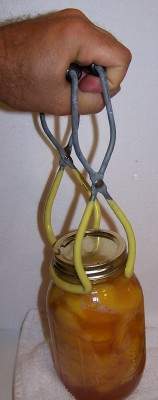 Lift
the jars out of the water and let them cool without touching or bumping
them in a draft-free place (usually takes overnight), here they won't be
bumped. You can then remove the rings if you like, but if you leave them on, at least loosen them quite a bit, so they don't rust in place due to trapped moisture. Once the jars are cool,
you can check that they are sealed verifying that the lid has been sucked
down. Just press in the center, gently, with your finger. If it pops up
and down (often making a popping sound), it is not sealed. If you put the
jar in the refrigerator right away, you can still use it. Some people
replace the lid and reprocess the jar, then that's a bit iffy. If you heat
the contents back up, re-jar them (with a new lid) and the full time in
the canner, it's usually ok.
Lift
the jars out of the water and let them cool without touching or bumping
them in a draft-free place (usually takes overnight), here they won't be
bumped. You can then remove the rings if you like, but if you leave them on, at least loosen them quite a bit, so they don't rust in place due to trapped moisture. Once the jars are cool,
you can check that they are sealed verifying that the lid has been sucked
down. Just press in the center, gently, with your finger. If it pops up
and down (often making a popping sound), it is not sealed. If you put the
jar in the refrigerator right away, you can still use it. Some people
replace the lid and reprocess the jar, then that's a bit iffy. If you heat
the contents back up, re-jar them (with a new lid) and the full time in
the canner, it's usually ok.
Mangoes, pears and apples may also
show a blue, red or pink color change after canning. This is the result of
natural chemical changes that sometimes occur as fruits are heated. It is
harmless and won't affect flavor!
Also, avoid storing canned food near heat sources such as a furnace,
water heater, hot water or sunny areas. Jars need to be kept cool and
dark for longer storage life and to protect against spoilage. Be sure to
store in a dry place. If the lid or band rusts, that can cause the seal to
break.



